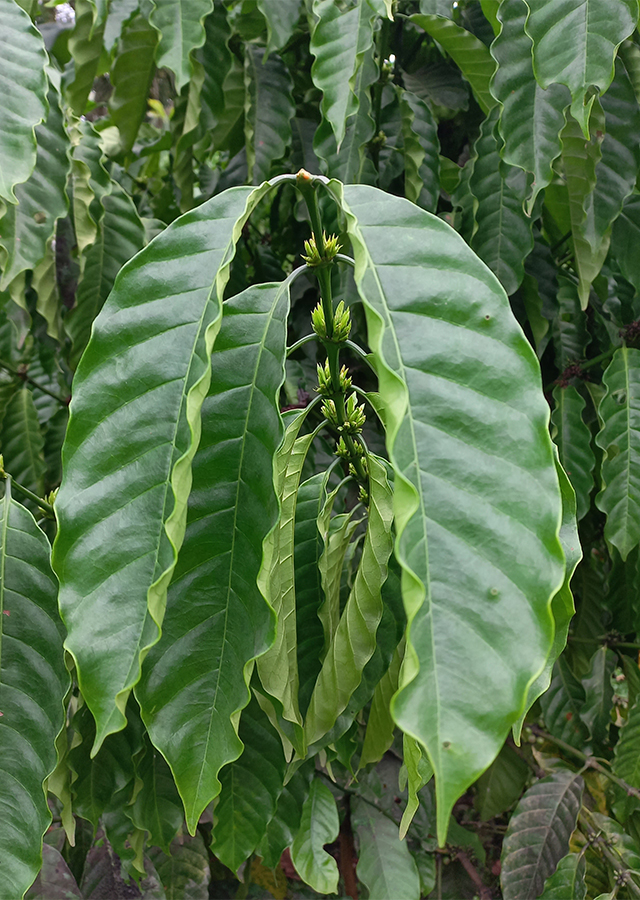Traditional Herbs from Coffea canephora
calming
- Take enough robusta coffee beans that have been dried and powdered.
- Boil the ground coffee beans.
- Strain then drink warm.
What is Coffea canephora Looks like??



Parts of Coffea canephora that could be used
- Leaves
- Seeds
- Roots
Coffea canephora Distribution
Robusta coffee is a type of coffee plant that originates from the northern forests of Ethiopia and now grows naturally throughout western and central sub-Saharan Africa (Liberia, Tanzania, Angola). This plant has naturalized and spread to other hot spots around the world, such as Vietnam, Nicaragua, Costa Rica, and the Lesser Antilles. Indonesia is one of the highest producers of robusta coffee. Robusta coffee was first introduced to Java in 1900 from the Congo. Currently, more than 90% of Indonesia's coffee plantation area consists of robusta coffee and its beans are used to produce around 20% of the world's coffee supply. This type of coffee contains more caffeine than Arabica. This type of coffee is also often used in the cosmetics and food industries, where because of the acid content in the beans, it is popularly used in facial or body masks to remove excess oil and dead cells and is used to give flavor and aroma to candy. In Java, robusta coffee is also often used by people to cover the smell of corpses before burial and coffee pulp and parchment are used as manure and mulch. In addition, based on research, it was concluded that robusta coffee beans have a high polyphenol content which plays an important role as an antioxidant. Roasted coffee and ground coffee are also traditional medicinal ingredients in Southeast Asia, one of which is used to relieve stomach aches and diarrhea.Agroecology of Coffea canephora
Robusta coffee is often found in open or dense rainforests, forest edges, and desert areas. This plant can grow optimally at an altitude of 500-700 m above sea level. Suitable rainfall for growing robusta coffee ranges from 1,500-2,500 mm per year, with an average dry month of 1-3 months and an average air temperature of 15-25 °C. Likes fertile, loose clay soil, rich in organic matter, well-drained, with neutral to slightly acidic soil acidity (pH) (5.5-6.5) and does not require alkaline soil, this plant is also resistant to temporary waterlogging . In general, coffee does not like large amounts of direct sunlight, but requires regular sunlight.
Morphology of Coffea canephora
- The taproot is shorter than Arabica coffee, has a shallow root system.
- Leaves are bright green, shiny, elliptical-oval or ovate-oval in shape with wavy leaf edges, pointed tip, wrinkled leaf texture, hairless on on both surfaces, the leaf blades are wider and thicker than Arabica coffee.
- Flowers are white to pink, funnel-shaped, star-shaped flower tube with 5-7 lobes, spatula-shaped narrow elliptical, obtuse to rounded. Inflorescence with 1-3 cymes in each leaf axil, each cyme consists of 3-6 flowers.
- Fruit is green when young and turns red when mature, shiny, round, smooth, not hairy.
- The seeds are slightly round and the curve of the seeds is thicker than Arabica coffee, the center line from top to bottom is almost flat, consisting of the seed coat and the substance.
Cultivation of Coffea canephora
- Propagation is carried out by vegetative methods (connections, cuttings, tissue culture) or generative (seeds).
- Cuttings: the coffee shoots used are still green and flexible, not too young or old, in segments 2-4 of the shoot. Cutting cutting material into one segment 6-8 cm long, a pair of leaves are cut, the base is cut at an angle in one direction. The prepared cuttings are planted by sticking the stem into the growing medium so that the leaves touch the surface of the media, then cover them with plastic. The cuttings are planted using a spacing of 5-10 cm. After the cuttings are 1 3 months old, they are adjusted by gradually opening the lid, and at the age of 1 4 months the cuttings are transferred to the seedling nursery ready to plant in the garden after 1 7 months of age in the nursery.
- Connection: rootstock seeds used are 5-6 month old plants and seed criteria ready to be grafted, the size of the rootstock is the size of a pencil. Grafting is done by cutting the lower stem of the seedling (15-20 cm high) and leaving 1-3 pairs of leaves on the lower stem, then slicing the middle of the stem 2-3 cm long, to connect the scion to the scion. (the top stem has its leaves removed and the scion base is sliced ??on both sides to form a V) then tie the joint.
Coffea canephora, more details :
Chemical Content of Coffea canephoraAlkaloids (caffeine), flavonoids, saponins, tannins, terpenoids, phenolic compounds (eruloylquinic acids (3-, 4- and 5-FQA), monoester isomers (3-, 4- and 5-CQA) and diesters (3,4- , 3,5- and 4,5-diCQA) CQAs.
Benefits of Coffea canephora
Relieves stomach ache and diarrhea, increases blood pressure, treats back pain, measles, coughs, jaundice, anorexia (eating disorder characterized by weight loss), antidote, diuretic, analgesic, aphrodisiac, galactagogue (stimulates breast milk production) , calming, and antioxidant.
Simplisia of Coffea canephora
- Prepare\u00a0robusta coffee fruit\u00a0and separate the red and green fruit.
- Dry in direct sunlight for several days or in an oven at a temperature\u00a040 \u00b0C\u00a0to moisture content\u00a010%.
- After dry, peel the skin of the fruit, take out the seeds.
- Store the coffee beans in a clean, airtight container.
Another Facts for Coffea canephora :
Synonym of Coffea canephoraCoffea bukobensis Zimm., Coffea laurentii De Wild., Coffea robusta L.Linden
Habitus of Coffea canephora
Bush. Shrub or small tree, annual, reaching 12 m in height
Habitat of Coffea canephora
- Forest
- Land
No comments:
Post a Comment